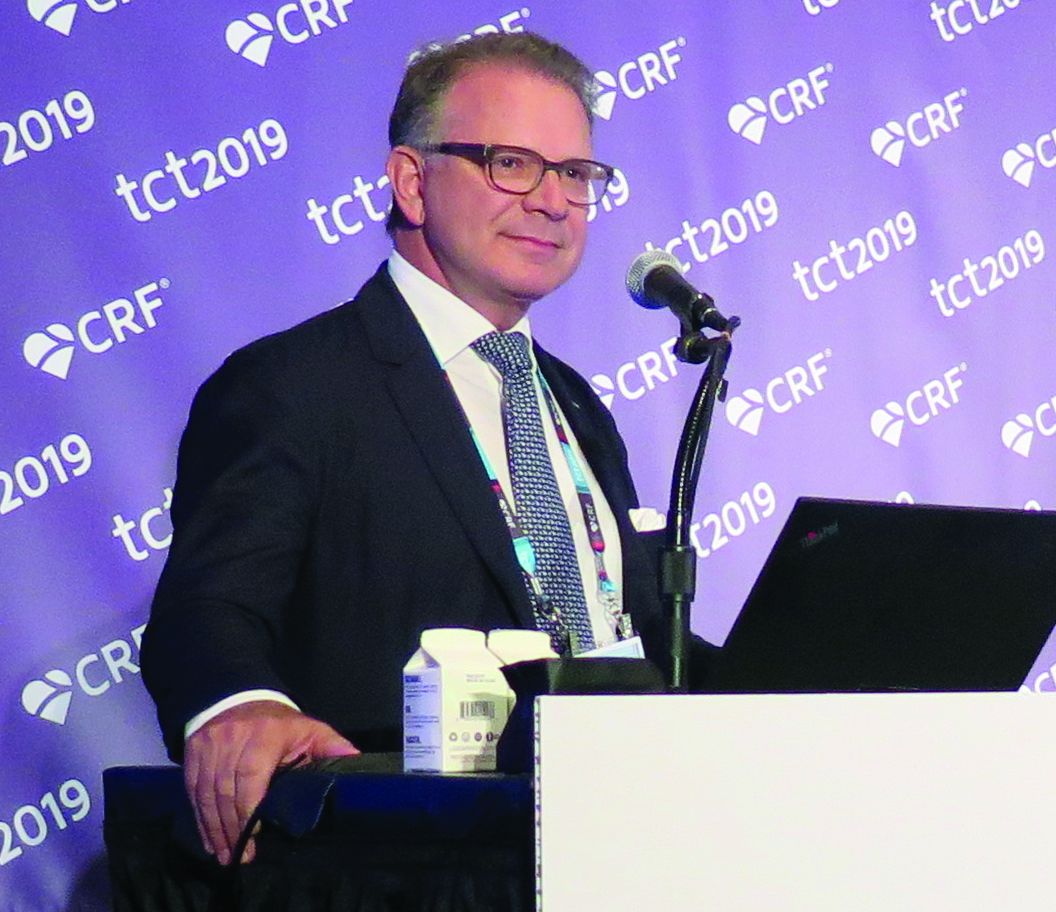User login
SAN FRANCISCO – An investigational device exemption trial of the Portico valve with FlexNav delivery system showed 1-year clinical results on par with commercially available valves, Gregory P. Fontana, MD, reported at the Transcatheter Cardiovascular Therapeutics annual meeting.
In a prospective, open-label study conducted at 52 sites known as PORTICO, Dr. Fontana and colleagues conducted a noninferiority intention-to-treat evaluation of the safety and effectiveness of the self-expanding Portico transcatheter aortic valve replacement system, compared with Food and Drug Administration–approved and commercially available TAVR systems for patients with severe aortic stenosis at high or extreme risk for surgery. Between May 2014 and June 2019, 750 patients from 69 sites were randomized 1:1 to each group. The prespecified primary safety composite endpoint was all-cause mortality, disabling stroke, life-threatening bleeding requiring blood transfusion, acute kidney injury requiring dialysis, or major vascular complications at 30 days, while the primary effectiveness composite endpoint was all-cause mortality or disabling stroke at 1 year.
The mean baseline age of patients was 83 years, 53% were female, and their mean Society of Thoracic Surgeons score was 6.5%. Dr. Fontana, director and chairman of cardiothoracic surgery at the CardioVascular Institute of Los Robles Regional Medical Center, Thousand Oaks, Calif., reported at the meeting sponsored by the Cardiovascular Research Foundation that procedural success was comparable between groups (96.5% for Portico vs, 98.3% for commercially available TAVR, respectively). In addition, patients in both groups met the prespecified primary safety composite endpoint (13.8% vs. 9.6%; P for noninferiority = .03) and the primary effectiveness composite endpoint (14.9% vs. 13.4%, P for noninferiority = .006).
However, the rate of moderate to severe paravalvular leak at 30 days was 6.3% among patients in the Portico valve group, compared with 2.1% of their counterparts in the commercially available TAVR group, a difference that did not reach noninferiority. Dr. Fontana said that a next-generation valve with design modifications to reduce paravalvular leak is being tested in clinical trials.
PORTICO included a separate cohort of 100 patients who underwent Portico valve implantation using the FlexNav Delivery System, which became available after the trial had launched. The primary safety endpoint for the FlexNav cohort was major vascular complication rate at 30 days. This cohort demonstrated no deaths or strokes, low rates of major vascular complications (7.0%) and new permanent pacemaker implants (14.6%), as well as a safety profile comparable with the commercially available valve group in the randomized study (8.0% vs. 9.6%).
“My sense of this device is that presumably it will be another valve we have available to us in the United States,” Pinak B. Shah, MD, a cardiologist at Brigham and Women’s Hospital, Boston, said during a media briefing. “The challenge to all of us is to figure out where it fits in our armamentarium. Is it going to be worth individuals to learn a whole new device when at this point it’s hard to say if there’s a major difference compared to the other self-expanding devices we have now?”
With the new FlexNav delivery system, the Portico valve is characterized by “a very calm, slow delivery,” said Dr. Fontana, who was the study’s coprincipal investigator, along with Raj R. Makkar, MD, director of interventional cardiology at Cedars-Sinai Medical Center, Los Angeles. “The operator can land the valve exactly where they want it. If they’re not happy, they can make some adjustments. I haven’t yet a system in my hands that is as stable as this. The option of having excellent hemodynamics and large cells to engage the coronary system is a unique combination for us in the United States.”
The Portico valve is not currently FDA approved. The PORTICO study was funded by Abbott. Dr. Fontana disclosed grant/research support from Abbott and Medtronic and consulting fees/honoraria from Abbott, Medtronic, and LivaNova.
SAN FRANCISCO – An investigational device exemption trial of the Portico valve with FlexNav delivery system showed 1-year clinical results on par with commercially available valves, Gregory P. Fontana, MD, reported at the Transcatheter Cardiovascular Therapeutics annual meeting.
In a prospective, open-label study conducted at 52 sites known as PORTICO, Dr. Fontana and colleagues conducted a noninferiority intention-to-treat evaluation of the safety and effectiveness of the self-expanding Portico transcatheter aortic valve replacement system, compared with Food and Drug Administration–approved and commercially available TAVR systems for patients with severe aortic stenosis at high or extreme risk for surgery. Between May 2014 and June 2019, 750 patients from 69 sites were randomized 1:1 to each group. The prespecified primary safety composite endpoint was all-cause mortality, disabling stroke, life-threatening bleeding requiring blood transfusion, acute kidney injury requiring dialysis, or major vascular complications at 30 days, while the primary effectiveness composite endpoint was all-cause mortality or disabling stroke at 1 year.
The mean baseline age of patients was 83 years, 53% were female, and their mean Society of Thoracic Surgeons score was 6.5%. Dr. Fontana, director and chairman of cardiothoracic surgery at the CardioVascular Institute of Los Robles Regional Medical Center, Thousand Oaks, Calif., reported at the meeting sponsored by the Cardiovascular Research Foundation that procedural success was comparable between groups (96.5% for Portico vs, 98.3% for commercially available TAVR, respectively). In addition, patients in both groups met the prespecified primary safety composite endpoint (13.8% vs. 9.6%; P for noninferiority = .03) and the primary effectiveness composite endpoint (14.9% vs. 13.4%, P for noninferiority = .006).
However, the rate of moderate to severe paravalvular leak at 30 days was 6.3% among patients in the Portico valve group, compared with 2.1% of their counterparts in the commercially available TAVR group, a difference that did not reach noninferiority. Dr. Fontana said that a next-generation valve with design modifications to reduce paravalvular leak is being tested in clinical trials.
PORTICO included a separate cohort of 100 patients who underwent Portico valve implantation using the FlexNav Delivery System, which became available after the trial had launched. The primary safety endpoint for the FlexNav cohort was major vascular complication rate at 30 days. This cohort demonstrated no deaths or strokes, low rates of major vascular complications (7.0%) and new permanent pacemaker implants (14.6%), as well as a safety profile comparable with the commercially available valve group in the randomized study (8.0% vs. 9.6%).
“My sense of this device is that presumably it will be another valve we have available to us in the United States,” Pinak B. Shah, MD, a cardiologist at Brigham and Women’s Hospital, Boston, said during a media briefing. “The challenge to all of us is to figure out where it fits in our armamentarium. Is it going to be worth individuals to learn a whole new device when at this point it’s hard to say if there’s a major difference compared to the other self-expanding devices we have now?”
With the new FlexNav delivery system, the Portico valve is characterized by “a very calm, slow delivery,” said Dr. Fontana, who was the study’s coprincipal investigator, along with Raj R. Makkar, MD, director of interventional cardiology at Cedars-Sinai Medical Center, Los Angeles. “The operator can land the valve exactly where they want it. If they’re not happy, they can make some adjustments. I haven’t yet a system in my hands that is as stable as this. The option of having excellent hemodynamics and large cells to engage the coronary system is a unique combination for us in the United States.”
The Portico valve is not currently FDA approved. The PORTICO study was funded by Abbott. Dr. Fontana disclosed grant/research support from Abbott and Medtronic and consulting fees/honoraria from Abbott, Medtronic, and LivaNova.
SAN FRANCISCO – An investigational device exemption trial of the Portico valve with FlexNav delivery system showed 1-year clinical results on par with commercially available valves, Gregory P. Fontana, MD, reported at the Transcatheter Cardiovascular Therapeutics annual meeting.
In a prospective, open-label study conducted at 52 sites known as PORTICO, Dr. Fontana and colleagues conducted a noninferiority intention-to-treat evaluation of the safety and effectiveness of the self-expanding Portico transcatheter aortic valve replacement system, compared with Food and Drug Administration–approved and commercially available TAVR systems for patients with severe aortic stenosis at high or extreme risk for surgery. Between May 2014 and June 2019, 750 patients from 69 sites were randomized 1:1 to each group. The prespecified primary safety composite endpoint was all-cause mortality, disabling stroke, life-threatening bleeding requiring blood transfusion, acute kidney injury requiring dialysis, or major vascular complications at 30 days, while the primary effectiveness composite endpoint was all-cause mortality or disabling stroke at 1 year.
The mean baseline age of patients was 83 years, 53% were female, and their mean Society of Thoracic Surgeons score was 6.5%. Dr. Fontana, director and chairman of cardiothoracic surgery at the CardioVascular Institute of Los Robles Regional Medical Center, Thousand Oaks, Calif., reported at the meeting sponsored by the Cardiovascular Research Foundation that procedural success was comparable between groups (96.5% for Portico vs, 98.3% for commercially available TAVR, respectively). In addition, patients in both groups met the prespecified primary safety composite endpoint (13.8% vs. 9.6%; P for noninferiority = .03) and the primary effectiveness composite endpoint (14.9% vs. 13.4%, P for noninferiority = .006).
However, the rate of moderate to severe paravalvular leak at 30 days was 6.3% among patients in the Portico valve group, compared with 2.1% of their counterparts in the commercially available TAVR group, a difference that did not reach noninferiority. Dr. Fontana said that a next-generation valve with design modifications to reduce paravalvular leak is being tested in clinical trials.
PORTICO included a separate cohort of 100 patients who underwent Portico valve implantation using the FlexNav Delivery System, which became available after the trial had launched. The primary safety endpoint for the FlexNav cohort was major vascular complication rate at 30 days. This cohort demonstrated no deaths or strokes, low rates of major vascular complications (7.0%) and new permanent pacemaker implants (14.6%), as well as a safety profile comparable with the commercially available valve group in the randomized study (8.0% vs. 9.6%).
“My sense of this device is that presumably it will be another valve we have available to us in the United States,” Pinak B. Shah, MD, a cardiologist at Brigham and Women’s Hospital, Boston, said during a media briefing. “The challenge to all of us is to figure out where it fits in our armamentarium. Is it going to be worth individuals to learn a whole new device when at this point it’s hard to say if there’s a major difference compared to the other self-expanding devices we have now?”
With the new FlexNav delivery system, the Portico valve is characterized by “a very calm, slow delivery,” said Dr. Fontana, who was the study’s coprincipal investigator, along with Raj R. Makkar, MD, director of interventional cardiology at Cedars-Sinai Medical Center, Los Angeles. “The operator can land the valve exactly where they want it. If they’re not happy, they can make some adjustments. I haven’t yet a system in my hands that is as stable as this. The option of having excellent hemodynamics and large cells to engage the coronary system is a unique combination for us in the United States.”
The Portico valve is not currently FDA approved. The PORTICO study was funded by Abbott. Dr. Fontana disclosed grant/research support from Abbott and Medtronic and consulting fees/honoraria from Abbott, Medtronic, and LivaNova.
REPORTING FROM TCT 2019

